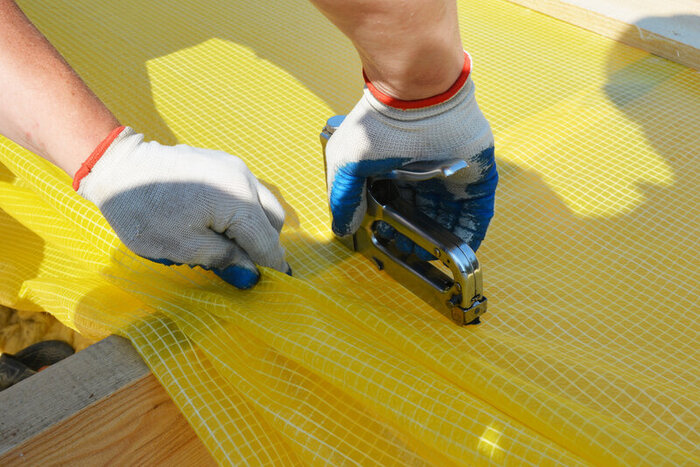
Our proximity to the ocean and cooler climates means Bay Area homes are vulnerable to moisture control issues. Poorly controlled moisture and indoor humidity levels lead to problems, ranging from condensation on the windows to structural rot and mold infestations. Vapor barriers work in tandem with insulation and ventilation systems to keep interior moisture levels to a minimum, enhancing whole-home comfort, energy efficiency, and air quality.
Vapor barriers, also called vapor retarders, can be used as part of a residential roofing system in conjunction with insulation inside exterior walls and crawl spaces with exposed earth. A vapor barrier is a kind of material that’s used to resist moisture from entering through the wall, ceiling, and even the floor. Water-water resistant materials come in sheets and are installed as per manufacturers’ instructions.
The ultimate goal of a vapor barrier is to prevent moisture accumulation (condensation) from migrating to the home’s interior. Therefore, there is no set standard as to how a vapor barrier is applied. However, in cooler, damper climates, we typically attach vapor barriers on the inside of exterior wall surfaces, mitigating the transfer of moisture that accumulates there via condensation - when the warmer interior air meets the cooler exterior surface of the walls.
In a warmer, humid climate, contractors typically apply vapor barriers to the exterior of the walls, underneath the siding, to mitigate moisture transfer that would seep from the exterior to the interior otherwise.
Some building codes require vapor barriers for specific locations. For example, the ICC’s International Residential Codes Chapter 7 states:
Exposed earth in unvented crawl space foundations shall be covered with a continuous Class I vapor retarder in accordance with this code.
Any uninsulated crawlspace within your home or property can present a severe disadvantage for your cooling and heating system. The damp soil within a crawlspace can often lead to cooler air rising through the house as well as odors making their way up into your property. This can often lead to unpleasant smells and issues with temperature control over time.
If you know you have bare earth and there is no vapor barrier in place, it’s time to contact an insulation contractor and schedule an inspection. Once vapor retardants are in place, you’ll notice a distinct difference in reducing HVAC demands, which directly translates to utility savings. In addition, if interior humidity, mold, or window condensation has been an issue in the past, you may notice these situations improve as well.
Here is the problem with vapor barriers: when they are needed, they make a difference. When they are not needed or if a vapor barrier is installed incorrectly, they wind up causing moisture issues. Always make sure you’re working with a licensed contractor before deciding to install vapor barriers so you can trust their judgment.
So, what’s the big idea about a little indoor humidity from time to time? The experts agree that ideal interior humidity levels are between 35% and 50%. You can purchase a humidity testing device online or at your local hardware store. If you are due for your annual HVAC maintenance appointment, ask the technician to test your humidity levels for you.
Reducing interior humidity levels to within that span has multiple benefits.
Damp makes hotter temperatures feel hotter and cooler temperatures feel colder. As a result, elevated interior moisture and humidity levels cause your HVAC system to work harder to meet the demands of your thermostat. Once your humidity levels are back under control, you’ll notice a decrease in energy spending related to home heating and cooling.
As the Bay Area heads into the cooler and moister winter season, ensure your home is ready for it by taking proactive measures to enhance insulation and moisture control.
By the time your home’s humidity level creeps above 55%, or so, mold becomes a very happy camper. Mold and mildew spores need three things to thrive: humidity, warmer temperatures, and something to eat. Your interior walls spaces, attics, blow-the-sink cupboards all offer exactly what these spores are looking for.
Unfortunately, mold and mildew cause structural rot, leading to costly repairs if it isn’t caught early enough. Those infestations make your house smell musty or “old” and they cause unsightly stains once they make their way into more visible locations. Then, there is the issue of compromised air quality (see #3).
Read 7 Harmful Molds That Could be Hiding in Your House to learn more about Bay Area mold cultures and how to detect and eliminate them.
As if that weren’t enough, other pests like cockroaches, silverfish, earwigs, mosquitoes, and centipedes also prefer humidity levels above 55%, so getting moisture levels under control supports pest control, too.
Have a family member who is prone to asthma attacks or respiratory problems? If so, you’ll definitely benefit from ensuring whole-home humidity (via updated insulation, vapor barriers, and ventilation are in place) and that supports healthy indoor air quality.
According to the EPA, “Americans, on average, spend approximately 90 percent of their time indoors, where the concentrations of some pollutants are often 2 to 5 times higher than typical outdoor concentrations.” If humidity levels are higher, indoor air quality is diminished by increased mold/mildew spores, dust mites, and other pollutants.
Using vapor barriers as a foundation to whole-home humidity control also has a positive effect on your home’s indoor air quality (IAQ), which can reduce allergy symptoms and respiratory illnesses.
Would you like to learn more about vapor barriers and whether vapor barrier installation would benefit your Bay Area home? Contact Attic Solutions to schedule a free, no-obligation consultation. We can look into your attic and crawl spaces to identify what if anything would make a difference for your comfort and peace of mind.